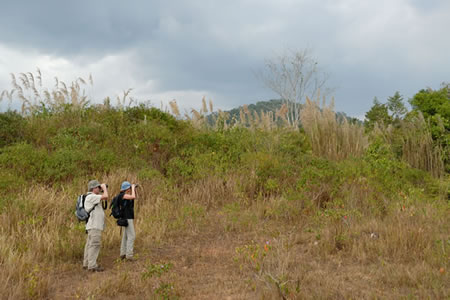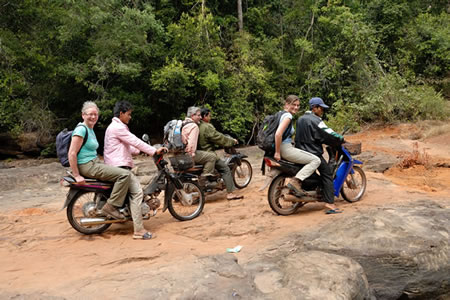English | Dutch |
|
| The Cardamom Mountains | |
Phnom Penh (Cambodia), February 1st 2009 |
|
This article is written by Franka, the mother of Ivonne When we were preparing our journey to South East Asia, we researched the possibility to visit the Cardamom Mountains, in the South-western part of Cambodia. Our main goal was to watch birds and enjoy the jungle environment. It was difficult to get information, because it is still a rarely visited area. We read on the internet that there should be a possibility to stay in a room at the ranger station in the small village of Thma Bang (GPS coordinates Thma Bang: N11˚41.073 – E103˚26.355), 60 kilometres away from the town Krong Koh Kong. That was all we could find. We arrived on January 25th in the little town of Krong Koh Kong. Edwin and Ivonne tried to make a phone call to the ranger station at Thma Bang, with a mobile phone that they borrowed at one of the mobile phone stalls on the market of Krong Koh Kong. It was the same stall as where we exchanged some Thai Baht in Cambodian Riels. Nobody answered the phone. However, five minutes later, the owner of the mobile phone came back to us to say that the ranger of the ranger station called him back. The ranger told us that it is possible to stay at his ranger station, but that we have to bring our own food. There should be somebody around who could prepare the food for us for a small fee. We told the ranger that we first wanted to arrange transport to his ranger station and that we should call him back as soon as we knew when we would arrive at his ranger station. The next step was to arrange transport. That wasn’t easy. The holiday of the Chinese New Year was going on and the road to Thma Bang seemed to be very bumpy, so nobody was eager to bring us to Thma Bang. We found somebody who was willing to bring us and pick us up a couple of days later, for the amount of US$ 150. We found that amount too high. A couple of minutes later a tuc-tuc driver approached us and told us that he knew somebody who would do it for 120 US$. We agreed with the price, but after 15 minutes it appeared to be not true. After two hours of asking around we decided to stay the night in Krong Koh Kong and to try again the next day. |
|
 |
|
The Cardamom Mountains are a great place for bird watching |
|
The same evening we were lucky. We finally found somebody who wanted to bring us to Thma Bang the following day. The next day at 8 o’clock in the morning, and old Toyota Camry stopped in front of our guesthouse. Before we left for Thma Bang, we brought a visit to the local market to buy food for the coming days: 16 packages of instant noodles, 36 litres of mineral water, 3 packages of sugar biscuits, 3 bags of potato chips, 24 buns, 1 jar of jam, 1 tin of fish and 30 bananas. When we arrived at the car, the driver started laughing. “You can also buy the bananas over there, they have a lot of them!” is what he mentioned. That was not what we wanted to hear, because banana plantations mean that the jungle is partly gone. With the trunk of the car full of food, we started driving towards the Cardamom Mountains. The first 25 kilometres were over a perfectly plastered road. But after this first stretch we left the asphalt road and entered a dusty gravel path. The remaining 35 kilometres went over a bumpy and rocky sand path. We had to leave the car several times to make it easier for the driver to navigate his car over this “Paris-Dakar” track. The road was bumpy but very beautiful. It was a great way to see the traditional Cambodian village life in a more remote part of the country. All houses are built on wooden poles. Most people spent their days in hammocks or on wooden planking under their houses, or are working on the fields. And indeed, it was what we expected: there are a lot of banana plantations. Big parts of the jungles are cleared to make it possible for these people to make a living. It is a sad sight, but understandable. The people were very friendly. Most people waved to us and gave us a big smile when we passed by in our old Toyota Camry. They do not see a lot of foreigners here. We saw people washing their laundry in small streams that were also used by the children as toilet. Some men were carrying heavy buckets of water while others were taking care of their valuable water buffaloes. Local people are using small motorcycles are their main means of transport. A small motorcycle can take a whole family: father, mother, and one or two children. Besides that, Cambodians are experts in loading their motorcycles with huge amounts of goods, from piles of bamboo to living livestock. | |
 |
|
The more remote areas of the Cardamom Mts are reachable by motorcycle |
|
| Just after we arrived at the ranger station, we went walking to explore the area around the ranger station. We saw already very nice birds, like Scarlet Minivets, Bee-eaters, Barbets and Hill Myna’s. We also saw and heard the Plain-Pouched Hornbill. That was great! The sound of its wings while flying is unforgettable. On the second day of our visit, we decided to go with a local guide to one of the waterfalls in the area. We had to hire four motorcycles with drivers to bring us to the start of the trail, 12 kilometres from the ranger station. The ride in itself was already a big adventure. It was like driving on the back of a motor cross professional. At that time it wasn’t so funny, but after we survived it, it really was. My driver was driving very fast, but he had the motorcycle under control. He steered his motorcycle without a lot of problems around the holes and rocks on the trail. Sometimes we had to cross a small ramshackle bamboo bridge, and while others had to step off their motorcycles, my driver crossed the bridge without any problems, with me still sitting on the back.
For me, everything went a little bit too fast. I am not 16 years old anymore. We arrived first at the start of the jungle trail. When I was waiting for the others to arrive, the adrenaline was still howling through my body. I told the driver that he drove too fast for me, but like I said before, it was quite fun knowing that I survived this ride. The trek with the guide was disappointing. He did not know how to speak English so he couldn’t explain a lot. Besides that, the trail was along a river and we had to climb over a lot of big and slippery rocks, making the trail very heavy. The jungle was very dense, making it impossible to see any birds or other wildlife. But we saw also some beautiful things. One of the amazing things we saw was a huge column of jungle ants. They were marching over the rocks in an almost never ending column; we couldn’t find the start or the end. We also saw a lot of very small white spiders on a branch in the jungle. “This looks like National Geographic Channel” is what we said to each other. After more than an hour of climbing over the rocks, we decided to go back and to spend the afternoon around the ranger station. When we arrived again at the start of the trail, where the motorcycles were still waiting for us, a lot of local people arrived to swim in the refreshing water of the river. “Happy New Year”, is what they yelled to us. We had to shake hands with several local people, before we could leave again. The afternoon walk was fantastic. We saw a lot of birds, like among others the Red-throated Flycatcher, the Great Hornbill, the Grey-capped Pygmy Woodpecker, the Black-napped Oriole and different kind of Barbets. The following day we had to finish our visit to the Cardamom Mountains. We had a bipartite feeling about it. On one hand we were disappointed by the fact that a lot of the jungle is cleared. On the other hand, we saw a lot of beautiful birds, making it a great area to visit for birdwatchers. Also the people were very friendly and they were happy to host us as guests. The accommodation is very basic but clean, and the people of the ranger station are very hospitable. When we opened the door of our room in the morning of our departure, an Oriental Pied Hornbill was sitting in the tree next to our accommodation to say goodbye to us and the lady of the ranger station treated us once again with a nice pot of tea and a plate of fresh Papaya. Super! |
|